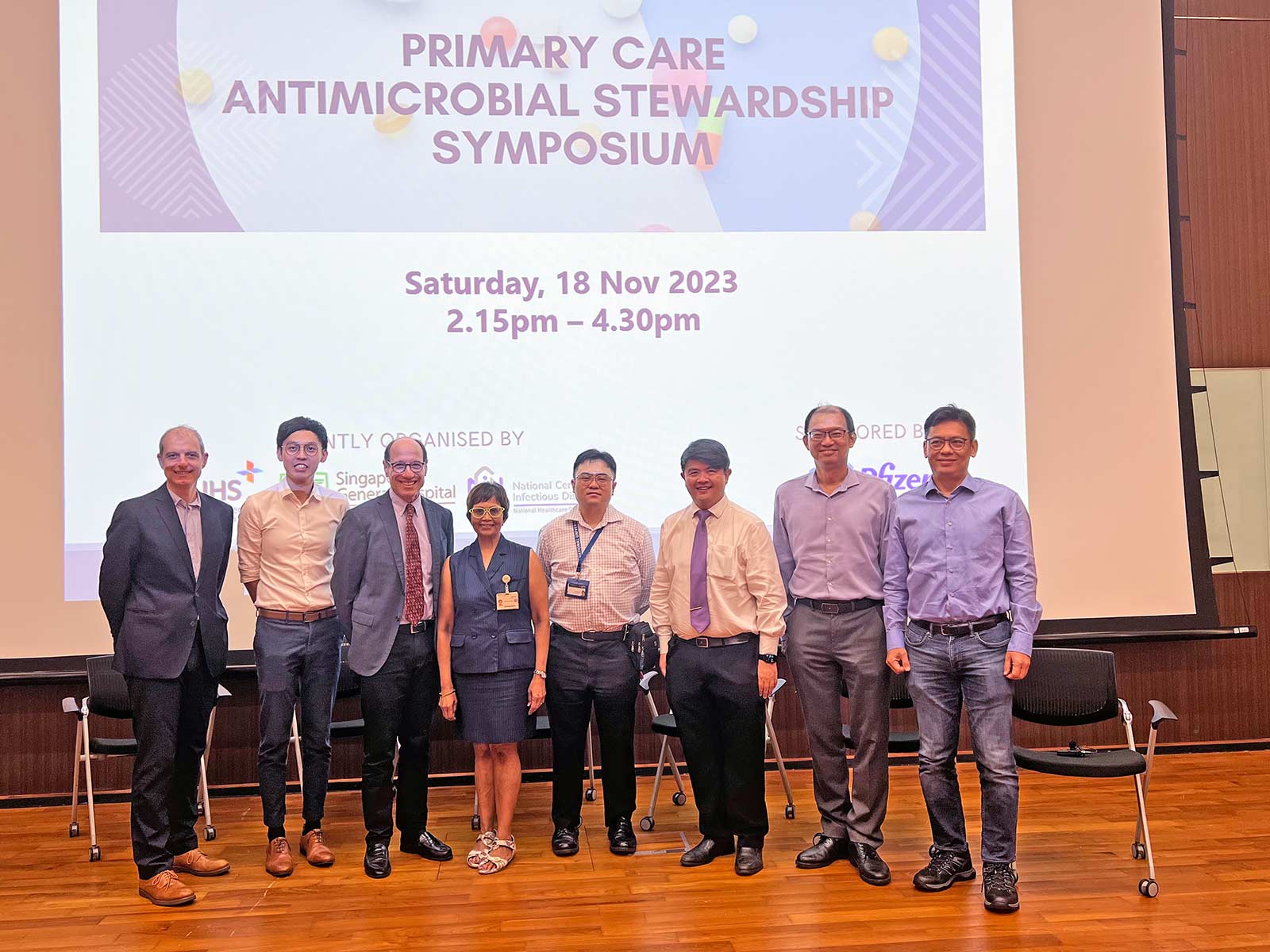Patients treated with ciprofloxacin or co-trimoxazole exhibited a
50%
increased likelihood of treatment failure and a
61%
higher risk of returning earlier for treatment failure

Issue 50
May 2024
ALL IN THE FAMILY
By Dr Sky Koh Wei Chee, Family Physician and Associate Consultant, National University Polyclinics

Antimicrobial resistance (AMR) remains one of the most critical global public health challenges today. The battle against AMR hinges on curbing inappropriate usage of antibiotics, upholding effectiveness through adherence to evidence-based guidelines and bolstering stewardship, particularly within primary care.1
In 2011, the Ministry of Health (MOH) mandated the implementation of antimicrobial stewardship programmes (ASPs) across public acute hospitals.2 This spurred the creation of the National Strategic Action Plan (NSAP) on Antimicrobial Resistance in 2017, a collaborative effort involving four government agencies adopting a One Health approach.3
The Plan provides a framework to strengthen and enhance activities to combat AMR, addresses identified gaps and prioritises future interventions. It builds on many years of work to combat AMR in Singapore, and unifies existing initiatives mounted across the human, animal, food, and environment sectors. The Plan aims to reduce the emergence and prevent the spread of drug-resistant organisms through five core strategies:
|
• |
Education; |
|
• |
Surveillance and Risk Assessment; |
|
• |
Research; |
|
• |
Prevention and Control of Infection; and |
|
• |
Optimisation of Antimicrobial Use |
However, progress in primary care has been limited due to ongoing challenges, including outdated antimicrobial guidelines since 2006, the absence of an outpatient ASP, and focus on controlling the COVID-19 pandemic.2,4 These issues, compounded by public misconception, contribute to the prevalent problem of over-prescription and inappropriate antimicrobial use in primary care.5,6
Concentrating efforts on addressing AMR in primary care not only has the potential to improve immediate outcomes, but also positively impact the broader systemic healthcare. Recognising the imperative for change and the pivotal role of primary care, AMR and infectious diseases have emerged as key research pillars within the Division of Family Medicine. This commitment is underscored by the collaboration with National University Polyclinics (NUP), solidifying our role as a partner institution in the MOH National Medical Research Council (NMRC) Centre Grant for Collaborative Solutions Targeting Antimicrobial Resistance Threats in Health Systems (CoSTAR-HS).
Birth of the study
The research team swiftly identified a pressing need in the national effort to enhance community AMR—update the existing knowledge and evidence related to antibiotic use in treating common infections in primary care. The team’s inaugural paper, titled “Prescribing Antibiotics in Public Primary Care Clinics in Singapore: A Retrospective Cohort Study,”7 published in Antibiotics (MDPI) in April 2023, detailed antimicrobial usage trends and indications.
Concentrating efforts on addressing AMR in primary care not only has the potential to improve immediate outcomes, but also positively impact the broader systemic healthcare. Recognising the imperative for change and the pivotal role of primary care, AMR and infectious diseases have emerged as key research pillars within the Division of Family Medicine.”
This study pinpointed key areas for intervention, highlighting skin and soft tissue, urinary, and respiratory tract infections as the top three most common conditions requiring antibiotics in primary care. This spurred us into examining urinary tract infections (UTIs), where a previous study had found higher resistance rates of urinary Enterobacteriaceae isolates (the most common genus causing UTIs) towards ciprofloxacin and co-trimoxazole, compared with co-amoxiclav and nitrofurantoin.8 In-vitro microbiological resistance does not reliably predict clinical outcome and successful infection resolution.9
We hypothesised that prescribing empirical antibiotics with higher resistance rates will lead to incomplete bacterial eradication, resulting in an increased risk of treatment failure (persistent symptoms with re-presentation or hospitalisation due to complications). Therefore, we proceeded to compare empirical treatment using co-amoxiclav or nitrofurantoin with ciprofloxacin or co-trimoxazole, for uncomplicated UTIs. The outcome for this study was treatment failure, which was defined as re-attendance for symptoms and antibiotic re-prescription, or hospital emergency department (ED) visits or admissions for UTI complications. To acquire linked health records data, we collaborated with our National University Health System (NUHS) partners and specialist experts, such as Professor Paul Anantharajah Tambyah, Infectious Disease, National University Hospital (NUH), Dr Pradeep Durai, Urology, Ng Teng Fong General Hospital (NTFGH), and Dr Louisa Sun, Infectious Disease, Alexandra Hospital (AH).
This collaborative, cross-institutional study titled “Antibiotic Treatment Failure of Uncomplicated Urinary Tract Infections in Primary Care,”10 published in BMC Antimicrobial Resistance & Infection Control in August 2023, involved an extensive cohort of over 3,000 patients who sought care at NUP between 2019 and 2021 for uncomplicated UTIs. Patients treated empirically with amoxicillin-clavulanate, nitrofurantoin, ciprofloxacin, or co-trimoxazole were longitudinally followed for 28 days, with hospital records cross-referenced for admissions and ED visits. The study utilised a 2:1 propensity score matching to minimise selection bias and balance covariates, coupled with Cox proportional hazards regression for analysis. The study uncovered that Escherichia coli was the predominant organism causing uncomplicated UTIs (64.6%). Notably, sensitivity rates varied among antibiotics, with amoxicillin-clavulanate and nitrofurantoin showing higher efficacy. The mean age of patients with uncomplicated UTIs was 33, predominantly Chinese (58.0%), with amoxicillin-clavulanate being the most frequently prescribed antibiotic (36.4%). Following matching, patients treated with ciprofloxacin or co-trimoxazole exhibited a 50% increased likelihood of treatment failure (RR = 1.49, 95% CI 1.10–2.01) and a 61% higher risk of returning earlier for treatment failure (HR 1.61, 95% CI 1.12–2.33).
Benefit to physicians and the health system
This study supports doctors in making well-informed decisions regarding antibiotic choice for treating UTIs. The knowledge gained is particularly valuable for doctors aiming to adhere to evidence-based guidelines in UTI management, allowing them to optimise treatment strategies and mitigate the risk of AMR. Prescribing the most suitable antibiotics also indirectly alleviates the overall burden on healthcare resources. By minimising the need for patients to revisit polyclinics or seek ED or hospital care due to treatment failure, the study helps optimise appointment slots and resources, enhancing the efficiency of the healthcare system. This leads to improved outcomes, reduced costs, and a more sustainable healthcare approach.
This study supports doctors in making well-informed decisions regarding antibiotic choice for treating UTIs. The knowledge gained is particularly valuable for doctors aiming to adhere to evidence-based guidelines in UTI management, allowing them to optimise treatment strategies and mitigate the risk of AMR. Prescribing the most suitable antibiotics also indirectly alleviates the overall burden on healthcare resources.”
Benefit to patients
Patients stand to gain several benefits from this study. This study directly informs physicians to prescribe antibiotics which are less susceptible to antimicrobial resistance. It also provides patients with knowledge and empowers them to participate in shared decision-making with their physicians, fostering a collaborative approach to healthcare. This directly benefits the patients as they will have reduced risk of complications and recurrent symptoms, reduced costs as they do not need to return for review and repeat prescription, or attend hospitals for failed treatments.

Members of MOH ACE UTI guidelines workgroup as part of the experts panel at the symposium.
Benefit to community
A noteworthy impact within the community is this study’s direct contribution to the knowledge necessary for MOH Agency of Care Effectiveness (ACE) to develop and release its ACE Clinical Guidance (ACG) titled “Urinary Tract Infections — Appropriate Diagnosis and Antibiotic Use for Uncomplicated Cystitis and Pyelonephritis” in November 2023. The study affirms local urinary bacteria resistance patterns compared to previous antibiograms constructed in 2015, thus revitalising outdated antimicrobial guidelines and providing primary care physicians with updated directives. This not only offers a renewed sense of direction for physicians but also fosters anticipation for forthcoming guidelines from authorities. Moreover, the community benefits from a proactive approach to combatting AMR, contributing to the overall well-being of individuals. The appropriate and complete eradication of bacteria and resolution of infection also play a pivotal role in reducing AMR, extending the usability of antibiotics for the entire population. This, in turn, leads to improvements in cost savings and overall patient and ecological health. Additionally, this approach aligns with broader efforts to preserve the effectiveness of antibiotics, ensuring that patients receive targeted and appropriate treatments tailored to their specific health conditions.
World Health Organization. Antimicrobial resistance and primary care. 2018. Available online: https://apps.who.int/iris/bitstream/handle/10665/326454/WHO-HIS-SDS-2018.56-eng.pdf Accessed 24 January 2024.
Chua AQ, Kwa AL, Tan TY, Legido-Quigley H, Hsu LY. Ten-year narrative review on antimicrobial resistance in Singapore. Singapore Med J. 2019;60:387-96.
Agri-Food & Veterinary Authority of Singapore, Ministry of Health, National Environment Agency, National Water Agency. National Strategic Action Plan on Antimicrobial Resistance Singapore. 2017. Available online: https://www.ncid.sg/About-NCID/OurDepartments/Antimicrobial-Resistance-Coordinating-Office/Documents/National%20Strategic%20Action%20Plan%20on%20Antimicrobial%20Resistance.pdf Accessed 24 January 2024.
Pan DST, Huang JH, Lee MHM, Yu Y, Chen MI-C, Goh EH, Jiang L, Chong JWC, Leo YS, Lee TH, Wong CS, Loh VWK, Poh AZ, Tham TY, Wong WM, Lim FS. Knowledge, attitudes and practices towards antibiotic use in upper respiratory tract infections among patients seeking primary health care in Singapore. BMC Fam Pract. 2016;17:148.
Ministry of Health Singapore. Clinical Practice Guidelines: Use of Antibiotics in Adults. 2006. Available online: https://www.moh.gov.sg/docs/librariesprovider4/guidelines/cpg_use-of-antibiotics-in-adults-feb-2006f6e0e4f9dad34a1f8f07666a05ec59a1.pdf?sfvrsn=244726fe_0 Accessed 24 January 2024.
Lee T-H, Wong JG, Lye DC, Chen MI, Loh VW, Leo Y-S, et al. Medical and psychosocial factors associated with antibiotic prescribing in primary care: survey questionnaire and factor analysis. Br J Gen Pract. 2017 Mar;67(656):e168–77.
Koh SWC, Lee VME, Low SH, et al. Prescribing antibiotics in public primary care clinics in singapore: a retrospective cohort study. Antibiotics (Basel). 2023;12(4):762.
Ho HJ, Tan MX, Chen MI, Tan TY, Koo SH, Koong AYL, Ng LP, Hu PL, Tan KT, Moey PKS, Koh EYL, Wong CS, Lye DC, Tan NC. Interaction between antibiotic resistance, resistance genes, and treatment response for urinary tract infections in primary care. J Clin Microbiol. 2019;57(9):e00143-e219.
Davey P, Steinke D, MacDonald T, Phillips G, Sullivan F. Not so simple cystitis: How should prescribers be supported to make informed decisions about the increasing prevalence of infections caused by drug-resistant bacteria? Br J Gen Pract. 2000;50(451):143–6.
Koh SWC, Ng TSM, Loh VWK, et al. Antibiotic treatment failure of uncomplicated urinary tract infections in primary care. Antimicrob Resist Infect Control. 2023;12(1):73.
More from this issue
A WORLD IN A GRAIN OF SAND
When the Teacher Becomes a Learner

PEOPLE OF NUS MEDICINE
The Kindest Cut


